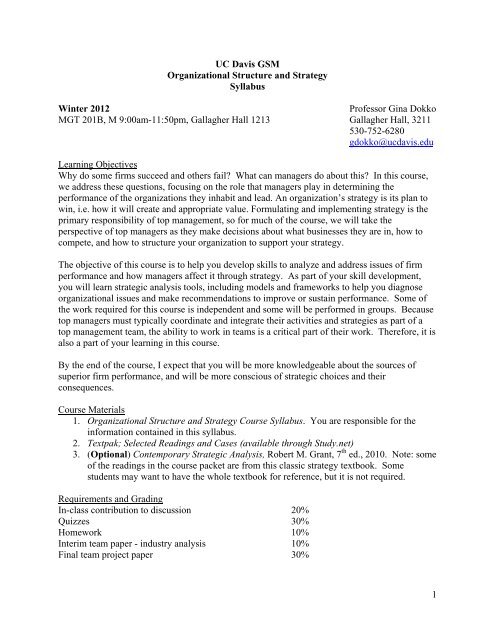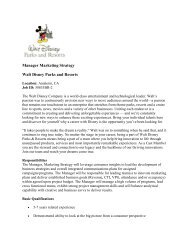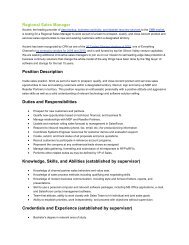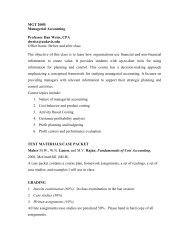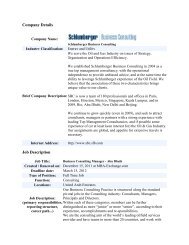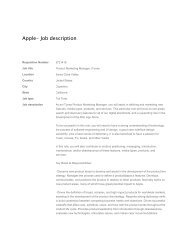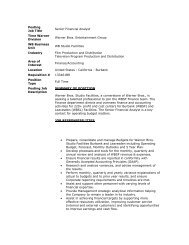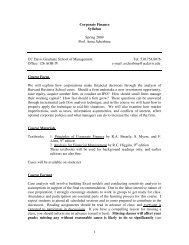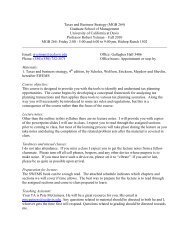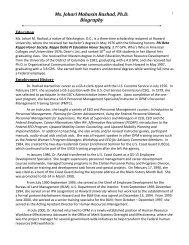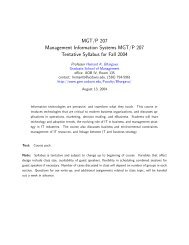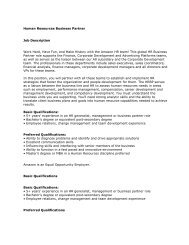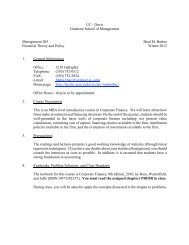MGT 201B - Students - UC Davis
MGT 201B - Students - UC Davis
MGT 201B - Students - UC Davis
Create successful ePaper yourself
Turn your PDF publications into a flip-book with our unique Google optimized e-Paper software.
<strong>UC</strong> <strong>Davis</strong> GSM<br />
Organizational Structure and Strategy<br />
Syllabus<br />
Winter 2012<br />
Professor Gina Dokko<br />
<strong>MGT</strong> <strong>201B</strong>, M 9:00am-11:50pm, Gallagher Hall 1213 Gallagher Hall, 3211<br />
530-752-6280<br />
gdokko@ucdavis.edu<br />
Learning Objectives<br />
Why do some firms succeed and others fail What can managers do about this In this course,<br />
we address these questions, focusing on the role that managers play in determining the<br />
performance of the organizations they inhabit and lead. An organization’s strategy is its plan to<br />
win, i.e. how it will create and appropriate value. Formulating and implementing strategy is the<br />
primary responsibility of top management, so for much of the course, we will take the<br />
perspective of top managers as they make decisions about what businesses they are in, how to<br />
compete, and how to structure your organization to support your strategy.<br />
The objective of this course is to help you develop skills to analyze and address issues of firm<br />
performance and how managers affect it through strategy. As part of your skill development,<br />
you will learn strategic analysis tools, including models and frameworks to help you diagnose<br />
organizational issues and make recommendations to improve or sustain performance. Some of<br />
the work required for this course is independent and some will be performed in groups. Because<br />
top managers must typically coordinate and integrate their activities and strategies as part of a<br />
top management team, the ability to work in teams is a critical part of their work. Therefore, it is<br />
also a part of your learning in this course.<br />
By the end of the course, I expect that you will be more knowledgeable about the sources of<br />
superior firm performance, and will be more conscious of strategic choices and their<br />
consequences.<br />
Course Materials<br />
1. Organizational Structure and Strategy Course Syllabus. You are responsible for the<br />
information contained in this syllabus.<br />
2. Textpak; Selected Readings and Cases (available through Study.net)<br />
3. (Optional) Contemporary Strategic Analysis, Robert M. Grant, 7 th ed., 2010. Note: some<br />
of the readings in the course packet are from this classic strategy textbook. Some<br />
students may want to have the whole textbook for reference, but it is not required.<br />
Requirements and Grading<br />
In-class contribution to discussion 20%<br />
Quizzes 30%<br />
Homework 10%<br />
Interim team paper - industry analysis 10%<br />
Final team project paper 30%<br />
1
Course Format and Administration<br />
Learning occurs both through preparing readings and cases and through in-class interaction.<br />
Therefore, it is critical that you attend class and come prepared to discuss the assigned material.<br />
Please let me know in advance if you are unable to attend a class.<br />
If you must miss the class with a quiz, you will receive a 0 on the quiz. It may be possible to<br />
make up the exam in very rare cases (travel or recruiting activities are not rare cases). In-class<br />
contributions to discussion cannot be made up.<br />
I will hold drop-in office hours on Mondays from 1:30-2:30 pm. I can also meet with you by<br />
appointment.<br />
Submitting Written Work<br />
1. Use Times New Roman, 12-point font, double-spaced with standard margins for all<br />
written assignments you submit.<br />
2. The following information must be included in the assignment header:<br />
a. Team name (if applicable)<br />
b. Your name (all names for team assignments)<br />
c. Word count<br />
3. Length limits are upper limits. Do not exceed the limit, and do not feel obligated to write<br />
more than you feel is needed, just to approach a length limit.<br />
4. To be fair to all students, I do not accept late assignments. Submit a hard copy of your<br />
assignments at the beginning of class on the due date.<br />
Preparing for case discussions<br />
To prepare for case discussions, read the assigned reading(s) for the week, and keep the<br />
concepts in mind as you read the case. The readings were selected to accompany the case,<br />
because they provide theoretical guidance for analyzing the case. Become familiar with the main<br />
characters in the case: their roles, actions and problems. Learn their names – otherwise your<br />
comments during class will be confusing.<br />
In-class contribution is an important part of our shared pedagogical experience. Your active<br />
participation helps me to evaluate your overall performance as a student. More importantly, the<br />
quality of the class itself is largely dependent on the quality of your collective discussion.<br />
Sections where the discussion is thoughtful and lively and where students engage with each other<br />
tend to have a better understanding of the course material and a better experience of the course<br />
than sections where students simply answer questions I ask. A high quality discussion requires<br />
hard work on your part. Before coming to class, read the case carefully enough to be fully<br />
conversant with the facts and have developed an informed opinion about what the firm or person<br />
should do. In class, pay attention to what others say. A good case discussion is a guided<br />
conversation, and responding to a classmate’s comment enhances the conversation. Repeating<br />
what others say or weighing in on a topic we have already left is not productive and shows that<br />
you are not following the discussion.<br />
2
The quality of your participation is more important than the quantity. Given our limited amount<br />
of time together, talking without positively contributing to the discussion will not result in the<br />
best grade for in-class contributions. However, I want to stress that positive contributions are not<br />
necessarily “right” answers. I encourage you to experiment and take risks. “Wrong” answers<br />
can also be instructive and debate is often a good way to learn. Positive contributions are those<br />
that advance the discussion by presenting new ideas or insights, or building on others’<br />
comments, or presenting a counterpoint to others’ comments in a respectful way.<br />
Some people are uncomfortable with presenting viewpoints in a large group setting. However,<br />
contributing to discussions is an important part of your development as a manager. I do call on<br />
students, so if you are unprepared for class one day, please let me know in advance and I will not<br />
call on you. If there is anything that may interfere with your ability to contribute in an effective<br />
way on an ongoing basis, please discuss it with me so that we can set mutually satisfactory<br />
expectations.<br />
In-Class Contribution<br />
<strong>Students</strong> who actively and positively contribute to case discussions are performing a service for<br />
the whole class by improving everyone’s learning and they will be rewarded accordingly. Inclass<br />
contributions are scored immediately after each class as follows. In class, as in life,<br />
showing up matters, and you’ll earn 2 points for that. Any attempt to contribute will merit one<br />
point, and positive contribution can earn up to two additional points. The class is richer if there<br />
are a diversity ideas voiced from a variety of students. However, I understand that this type of<br />
scoring can lead some students to say anything at all once per class to try to optimize their<br />
participation grade, rather than actually being engaged in the discussion. Such behavior will be<br />
noted; I find it as annoying as you do. At the same time, I understand that it is difficult to have<br />
full participation in large classes. Do your best. Though I may not be able to call on you every<br />
time, I will notice who’s involved in the conversation.<br />
At least once per class, I will ask you to use your i-clicker, so make sure to bring it to every<br />
class. Your responses will also serve as a backup record of your attendance.<br />
Quizzes<br />
There will be two quizzes in lieu of a final exam. The quizzes will be administered in the first<br />
hour of classes 4 and 8. Quizzes will test your knowledge of course concepts and will contain<br />
short applications of these concepts. Any material assigned or discussed before you take the quiz<br />
is fair game.<br />
Homework<br />
The homework assignment consists of answering case preparation questions associated with the<br />
case assigned for that week. Please choose one of the following cases to submit a homework<br />
assignment for: Cola Wars, Apple 2010, or Disney. The assignment is due at the beginning of<br />
the class where your selected case is discussed. Do not submit more than one homework<br />
assignment. The length limit for this assignment is 500 words.<br />
3
Team Project and Interim Team Analysis<br />
The Team Project is a strategic analysis of a firm in trouble. You will form teams in the first<br />
class, and your choice of firm is due in the second class. The firm you choose must be a<br />
publically held firm that is either performing worse than the industry average or whose<br />
performance has fallen significantly in the past few years. Use an appropriate measure of<br />
profitability (not stock price) to assess firm performance. Your strategic analysis is essentially a<br />
diagnosis of the firm’s problem(s), using course frameworks and theories that are relevant to the<br />
firm’s situation. Your analysis should also end with recommendations. These recommendations<br />
should flow naturally from your analysis, i.e. if your analysis of the firm’s structure reveals a<br />
mismatch between the firm’s organizational structure and its strategy, your recommendations<br />
should include either a change in strategy or a reorganization. More information about the final<br />
project will be forthcoming.<br />
To help you stay on track for the final project, each team will submit an interim team analysis.<br />
The interim analysis will analyze the industry your firm participates in, using the industry<br />
analysis tools you learned in weeks 1-2. The analysis should be very focused on the question of<br />
how much of the firm’s performance troubles are due to the industry it inhabits.<br />
The length limit for interim team analyses is 1000 words (about 3-4 pages). For the final paper,<br />
the page limit is 5000 words in total (about 17 pages). Do not feel obligated to use all of the<br />
pages if you don’t need them<br />
The final project paper is due at the beginning of the last day of class.<br />
Code of Academic Conduct<br />
I expect that all of you take <strong>UC</strong> <strong>Davis</strong>’ code of academic conduct as seriously as I do. Cheating<br />
is counter-productive to our shared learning goals. It is an academic conduct violation to present<br />
others’ ideas or writing as your own, or to discuss cases with students who have already analyzed<br />
the case in class. If you are uncertain about what constitutes an academic conduct violation,<br />
please see me, or refer to http://sja.ucdavis.edu/cac.html.<br />
4
Class Readings Cases Assignments<br />
1. Introduction Hambrick & Fredrickson. Are You Sure You<br />
Have a Strategy<br />
Porter. What is Strategy<br />
Collins & Hansen. What’s Luck Got to Do With<br />
It<br />
Competitive Strategy and Industry Structure<br />
2. Competitive advantage from Porter. The Five Competitive Forces That Shape<br />
the outside: Industry structure Strategy.<br />
Porter. Generic Strategies (Ch. 1, Competitive<br />
Advantage)<br />
Cola Wars<br />
Choice of firm for final project<br />
due<br />
Homework (choose only one)<br />
3. Competitive advantage from<br />
the inside: Resources,<br />
capabilities and competence<br />
Barney. Firm Resources and Sustained<br />
Competitive Advantage.<br />
Apple in 2010<br />
Homework (choose only one)<br />
Corporate Strategy and Organizational Design<br />
4. Organizational design and Nohria. Note on Organizational Structure.<br />
structure<br />
5. Putting it together: Value Grant, Ch. 14 of Contemporary Strategic<br />
chain analysis, Vertical Analysis.<br />
integration<br />
Eggers. Memo on Value Chain Analysis<br />
(handout)<br />
(review) Porter. What is Strategy<br />
Procter & Gamble:<br />
Organization 2005<br />
Zara<br />
Quiz I<br />
Interim team analysis due<br />
6. Corporate strategy:<br />
Diversification and alliances<br />
Grant, Ch. 16 of Contemporary Strategic<br />
Analysis.<br />
Schilling, Ch. 8 Collaboration Strategies.<br />
Disney<br />
Abgenix and the<br />
Xenomouse (in<br />
Schilling, Ch. 8)<br />
Homework (choose only one)<br />
Strategy and Corporate Social Responsibility<br />
7. Strategy and corporate social Porter & Kramer. Strategy and Society:<br />
responsibility<br />
Jackall. Moral Mazes.<br />
IKEA<br />
5
Strategy Implementation<br />
8. Strategy formulation and<br />
implementation<br />
Mankins & Steele. Turning Great Strategy Into<br />
Great Performance.<br />
(review) Collins & Hansen. What’s Luck Got to<br />
Do With It<br />
Honda (A)<br />
Quiz II<br />
9. Strategic decision-making Carter. The Late Shift. (p. 1-18).<br />
Whyte. Decision Failures.<br />
(review) Jackall. Moral Mazes.<br />
The Late Shift<br />
(video case, no<br />
prep necessary)<br />
Final project due<br />
6
Thinking through the case preparation questions are the first step in analyzing the case. Before<br />
class, use these questions and the week’s readings to help you start thinking along the lines of<br />
what’s important in the case. Note that answering these questions does not constitute a complete<br />
case analysis. We’ll finish the case analysis together in class.<br />
Cola Wars Continue: Coke and Pepsi in 2006<br />
1. Why, historically, has the soft drink industry been so profitable<br />
2. Compare the economics of the concentrate business to that of the bottling business.<br />
Why is the profitability so different<br />
3. How has the competition between Coke and Pepsi affected the industry’s profits<br />
Apple Computer, 2010<br />
1. What are Apple’s resources and have they changed over time<br />
2. Analyze the structure of the personal computer industry over Apple’s life. How have<br />
the dynamics of the PC industry changed<br />
3. How sustainable is Apple’s competitive position in PCs MP3 players<br />
Procter & Gamble: Organization 2005 (A)<br />
1. Why did the US organizational structure shift from product groupings in the 1950s to<br />
a matrix in the 1980s Why did the European organizational structure shift from<br />
geographic grouping in the 1950s to category management in the 1980s Why were<br />
the two structures integrated into a global cube in the 1990s<br />
2. What are the key distinguishing features of Organization 2005 Why did P&G adopt<br />
this structure<br />
3. Should Lafley make a commitment to keeping Organization 2005, or should he plan<br />
to dismantle it<br />
Walt Disney Co.: The Entertainment King<br />
1. Why has Disney been successful for so long<br />
2. What did Michael Eisner do to rejuvenate Disney Specifically, how did he increase<br />
net income in his first four years<br />
3. Has Disney diversified too far in recent years<br />
Zara: Fast Fashion<br />
1. Which of the international competitors listed in the case is the most interesting to<br />
compare to Inditex’s in terms of financial results (see pp. 4-8 and Exhibit 6) Why<br />
What do comparisons indicate about Inditex’s operating economics and relative<br />
working capital efficiency<br />
2. How do distinctive features of Zara’s business model affect its operating economics<br />
7
3. How sustainable is Zara’s competitive advantage versus the kinds of advantage<br />
typically pursued by other apparel retailers<br />
IKEA's Global Sourcing Challenge: Indian Rugs and Child Labor (A)<br />
Honda (A)<br />
1. How should Marianne Barner respond to the invitation for IKEA to have a<br />
representative appear on the upcoming broadcast of the German video program<br />
2. What actions should she take regarding the IKEA supply contract with Rangan<br />
Exports<br />
3. What long-term direction should she take regarding IKEA’s continued operation in<br />
India Should the company stay or exit How would you manage the impact of your<br />
recommendation<br />
1. What is the strategy that has allowed Honda to be so successful in the motorcycle<br />
industry and, in particular, in the United States<br />
2. What indications do you have that the strategy was planned in advance, or that the<br />
company stumbled onto its strategy<br />
The Late Shift: Letterman, Leno, and the network battle for the night.<br />
1. Make a "cheat sheet" to remind you about Johnny Carson, David Letterman, Jay<br />
Leno, John Agoglia, Warren Littlefield, Bob Wright, Helen Kushnick, and Robert<br />
Morton – who are they, what is their job and how are they related in the structure of<br />
NBC<br />
2. Make a "cheat sheet" of biases and political influences that affect decision making<br />
(use the Whyte article and the Jackall article).<br />
8


